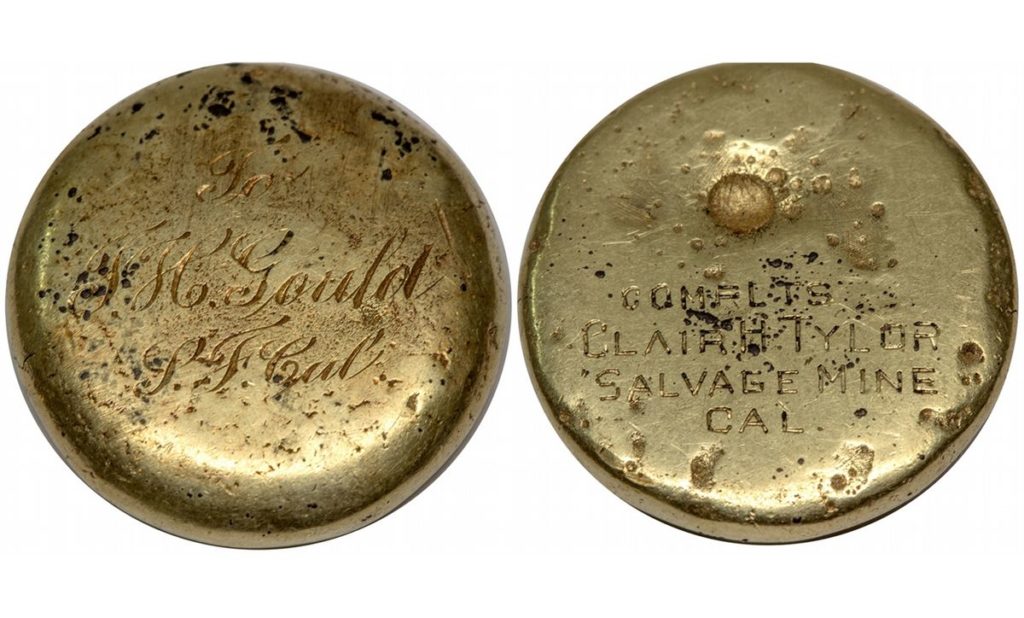1.2 oz Gould-Tylor Gold Ingot c1900

This small gold ingot was recently discovered. It reads “To F. H. Gould, S.F. Cal. Complts of Clair H. Tylor Salvage Mine Cal.” From the data, it appears this small, approximate 1.2 ounce gold ingot is a gift from Mr. Tylor to Mr. Gould, who was probably acting as his attorney. The recipient is Frank H. Gould, from Clair H. Taylor, and the “Salvage Mine”. The names are significant, as there is a story behind each. While the piece is undated, the piece appears to date about 1900.
The Principals
There is only one record of C.H. Tylor in American census data, and that for a surface miner (placer) in Downieville in 1870 (specifically noted as “mines above ground”.) Mr. Tylor was thus not only a miner, but a placer miner. Mr. Tylor, with his uniquely spelled surname, does not appear in any other census that I could find, thus he may have been a miner most or all of his life, living in various California mining camps, and did not participate in census gathering, not uncommon at the time.
Mr. Frank Horace Gould was born in Iowa in August 1856, as reported in all of his various biographies. He came overland to California in 1862. In 1879, he married his first wife, Hester A. Farnsworth. They had two girls. In 1880, he was living in Santa Clara, working as a teacher. He graduated from the Alabama State University of Law in 1887. By 1890, he was working in Merced as a lawyer, moving to Stockton shortly after. He was elected to the state legislature in 1893. About 1897 he moved to San Francisco, where his law practice and political career blossomed. There is much information on his life in California as a prominent attorney from 1893 until his death in 1918. [Ref: Men of the State of California, 1902, page 141; Who’s who in California, 1913; Herringshaw’s Blue Book of American Biography; various voter registration list]
Gould married a second time about 1894 and sued for divorce in 1899, finding his wife was a bit crazy (the suit is published online). Gould had a strong political presence, becoming the state Assemblyman in 1893, a member of the State Bar, Commissioner of the Building and Loan Assn., a U.S. Attorney, and a surveyor General of California. He died on 1918 of a heart attack at his office, subject to a divorce decree upon his death, leaving his estate to his first wife and their two daughters. Curiously, a conflict in his birth data exists in Census records. In the 1900 Census, the census taker listed Gould’s place of birth as Missouri, in August 1854, with both parents born in Missouri. But no other census record exist for him with these attributes. No census records were found for Francis, F.H., Frank H. or any permutations thereof. No census records were found for his wife, as listed in the 1918 Court proceedings as “E.B. Gould, and daughters A.N. Gould and Gladys V. Gould.” A second conflict arose regarding the marriage date of Gould and his second wife, as either 1894 or 1897.
Gould and a Courtroom Fight
In a well known incident in California jurisprudence, Gould was in a San Francisco courtroom in 1899, when he got into a fist fight with a disbarred lawyer, Mr. George Howe. Howe made flagrant statements to Gould, whereupon Gould hit Howe in the nose with a strong fist, sending Howe to the floor. The Judge fined both $25. How was admonished by Judge Kerrigan for starting the fight.
The mine name also invited investigation. For a closer look, I looked through various publications of the California Mining Bureau, and did not find a Salvage or Savage mine (I assumed “Salvage” was a misspelling of “Savage”, named after the famous Comstock mine of this name) in the following annual reports for all of California: 1888, 1890, 1893, 1894-6. I then proceeded to go back to Mr. Tylor’s time, and looked into the 1870-77 series Mineral Resources West of the Rocky Mountains (Ross Raymond), and found no such named mines in California. But after moving forward into Horatio Burchard’s Reports of the Director of the Mint, starting in 1880, I hit the jackpot in the 1882 volume (1881 data), page 98, listing the Savage Placer mine, which was, importantly, near Downieville, the same site as our Mr. Tylor. The mine was located ten miles southeast of Downieville, and as such an isolated locale, it was no wonder Mr. Tylor was not found in the 1880 census. In all likelihood, Mr. Gould acted as Mr. Tylor’s attorney regarding mining matters after his arrival in San Francisco. It may this be a small melted product of one of Mr. Tylor’s Placer mines in Downieville, from the circa 1897-1910 period.
The ingot itself is 1″ round and about 1/8th inch thick. In the mining business, we call these “buttons”. This one may be the product of a metal detector find, as it retains foreign material on parts of the surface.
[09/2014] https://www.icollector.com/Gould-Tylor-Gold-Ingot-c1900_i20352884 ($5,616)
